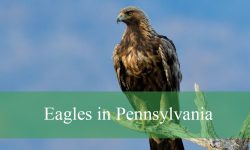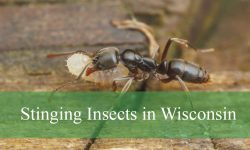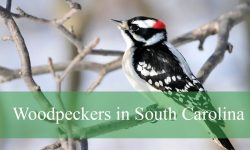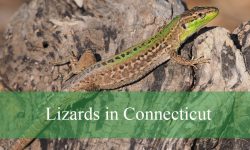North Carolina is home to a vibrant variety of bird species, and among them, blue birds stand out with their striking colors and captivating behaviors. For birdwatchers and nature lovers alike, exploring the 13 blue birds in North Carolina reveals an exciting array of feathered friends.
This guide to blue birds in North Carolina offers detailed descriptions and clear photos to help you identify each species with ease. From the bright Eastern Bluebird to the graceful Tree Swallow, these birds bring color and life to forests, fields, and gardens throughout the state.
Learning about the 13 blue birds in North Carolina enhances your outdoor adventures and connects you more closely to the region’s natural beauty. Discover their unique habits, habitats, and seasonal patterns to fully appreciate these stunning creatures.
Common Blue Birds Found in North Carolina
Indigo Bunting
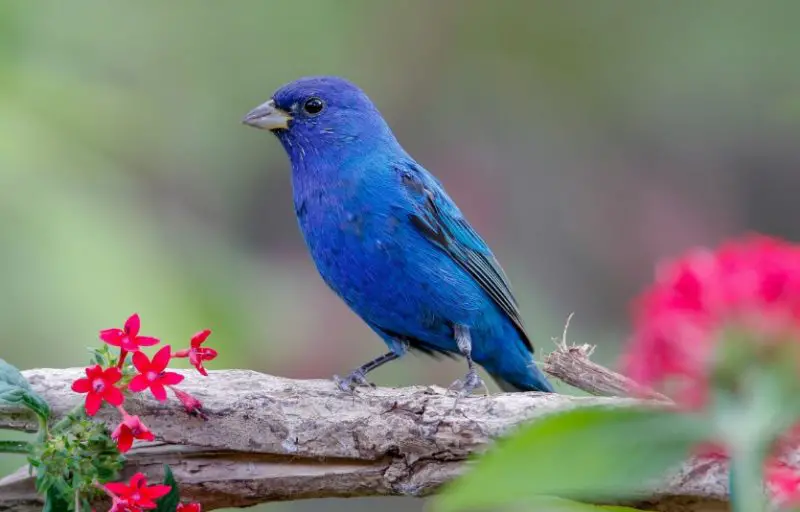
The Indigo Bunting is a small songbird celebrated for its dazzling bright blue coloration, especially vivid in males during the breeding season. Typically measuring about 4.7 to 5.1 inches (12 to 13 cm) in length, these birds have a slim build with a short, conical bill adapted for seed eating. Females and non-breeding males show a more muted brownish or blue-gray color, which helps them blend into foliage. Their high-pitched, musical song is a common sound across their range.
Indigo Buntings are highly active and often found perched conspicuously on shrubs or low trees, where males sing to establish territories. Their diet consists mainly of seeds, berries, and insects, allowing them to thrive in a variety of habitats including woodland edges, brushy fields, and overgrown pastures. They build cup-shaped nests in dense shrubs or small trees, providing shelter and camouflage for their young.
In North Carolina, Indigo Buntings are widespread and common, residing year-round and breeding throughout the state. Their presence is especially noticeable in spring and summer when males sing to attract mates. These birds are a favorite among local birdwatchers due to their vibrant colors and distinctive songs, easily found in both rural and suburban environments.
Eastern Bluebird
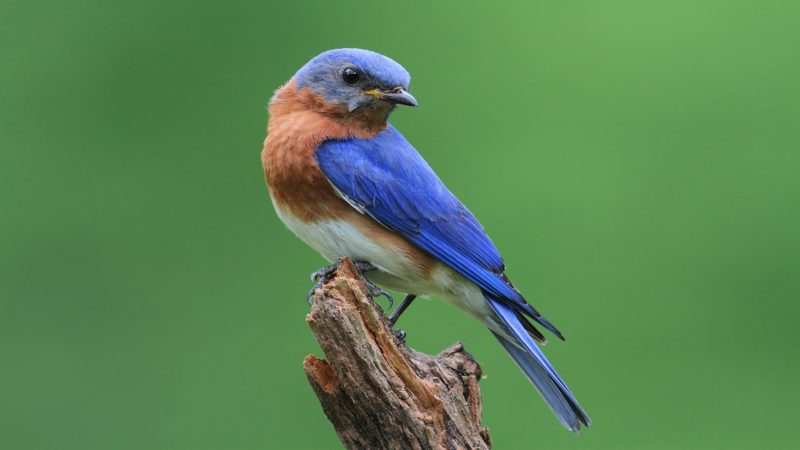
The Eastern Bluebird is a medium-sized thrush measuring about 6.3 to 8.3 inches (16 to 21 cm) in length, easily recognized by its vivid blue upperparts and rusty red throat and chest. Males display brighter and more saturated colors compared to females, who tend to have softer blue tones and paler underparts. Their melodious, flute-like songs and soft warbling calls are often heard in open fields and woodlands.
This species primarily feeds on insects, such as beetles, grasshoppers, and caterpillars, as well as wild fruits and berries, especially during the colder months. Eastern Bluebirds are cavity nesters, often using natural tree holes or man-made nest boxes. They prefer open habitats like meadows, orchards, and parks, where they perch visibly on wires or low branches while hunting for prey on the ground.
In North Carolina, Eastern Bluebirds are common year-round residents and breeders. They thrive in open rural and suburban areas throughout the state, with bird enthusiasts often encouraging their presence by providing nesting boxes. Their bright plumage and gentle song make them a beloved symbol of spring and summer in North Carolina.
Purple Martin
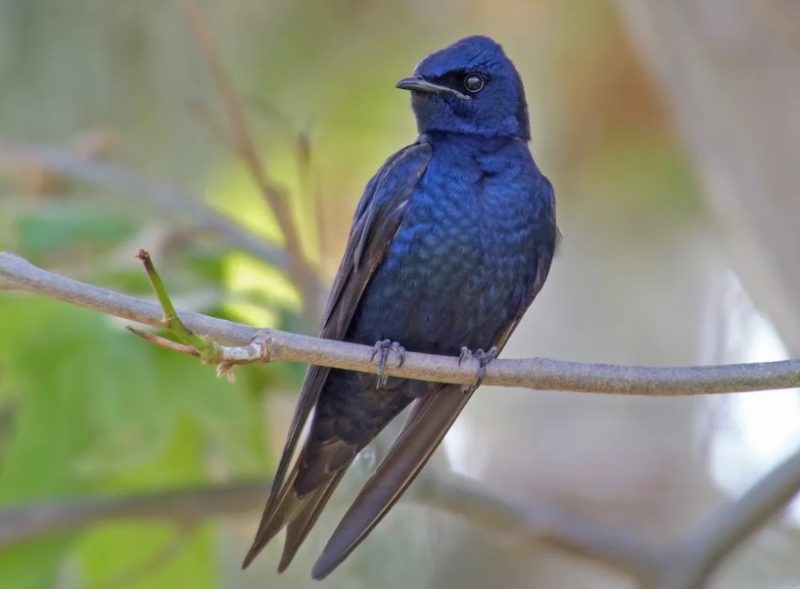
Purple Martins are the largest North American swallows, measuring about 7.9 to 9.1 inches (20 to 23 cm) long, notable for their iridescent dark purple-blue plumage that gleams in the sunlight. Males are solid glossy purple-black, while females and juveniles have duller grayish underparts. These birds have broad, pointed wings and a slightly forked tail adapted for sustained flight.
Their diet mainly consists of airborne insects, which they catch during swift, graceful flights over open areas and water. Purple Martins are highly social, nesting colonially in large groups within artificial houses or natural cavities. They depend heavily on human-provided nesting sites in many parts of their eastern range.
In North Carolina, Purple Martins are widespread and quite common during the breeding season. They arrive in spring, establishing colonies in suburban yards and open landscapes, and are celebrated for their aerial acrobatics and communal behaviors. Their presence adds a dynamic and beautiful dimension to North Carolina’s spring and summer birdlife.
Blue Jay

The Blue Jay is a striking, medium-sized songbird measuring about 9 to 12 inches (23 to 30 cm) in length, easily recognized by its vibrant blue plumage, white underparts, and distinctive crest on its head. Its wings and tail feature bold black and white barring, making it one of the most colorful and easily identified birds in eastern North America. Blue Jays are known for their loud, varied calls, including harsh “jay” sounds and melodic whistles.
Blue Jays are omnivorous and highly adaptable feeders, consuming a wide range of foods such as nuts, seeds, insects, small vertebrates, and occasionally eggs or nestlings of other birds. They are known for their intelligence and complex social behaviors, including caching food for later consumption and mimicking the calls of hawks to deter predators or competitors. Blue Jays often forage both on the ground and in trees.
In North Carolina, Blue Jays are common year-round residents found throughout forests, suburban areas, and parks. Their bold coloration and noisy presence make them highly noticeable, and they play an important ecological role in seed dispersal, especially of oak trees. Birdwatchers appreciate their lively behavior and striking appearance across the state.
Belted Kingfisher
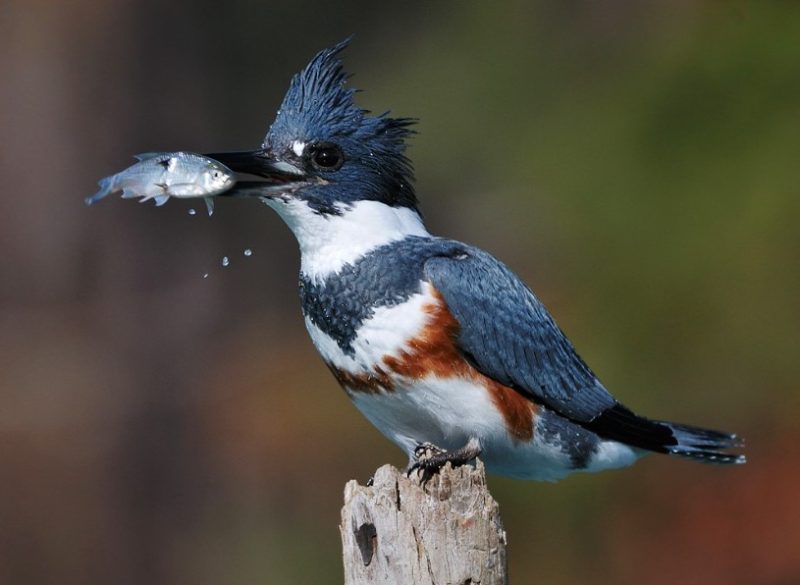
The Belted Kingfisher is a robust bird roughly 11 to 14 inches (28 to 35 cm) in length, known for its shaggy crest and striking blue-gray coloration with a white collar around the neck. Females often have a rusty-colored band across the chest, a unique trait among kingfishers. Their large, strong bill is perfectly adapted for catching fish and aquatic prey.
Belted Kingfishers are skilled hunters, diving headfirst into streams, rivers, lakes, and ponds to catch fish, crustaceans, and amphibians. They perch prominently on branches or wires near water, watching for movement below. These birds nest in burrows excavated in steep riverbanks or soft soil near water bodies.
In North Carolina, Belted Kingfishers are common year-round residents, especially abundant near rivers, creeks, lakes, and reservoirs. Their loud, rattling calls often echo along the water’s edge, making them easy to detect even when hidden in dense riparian vegetation.
Blue-gray Gnatcatcher
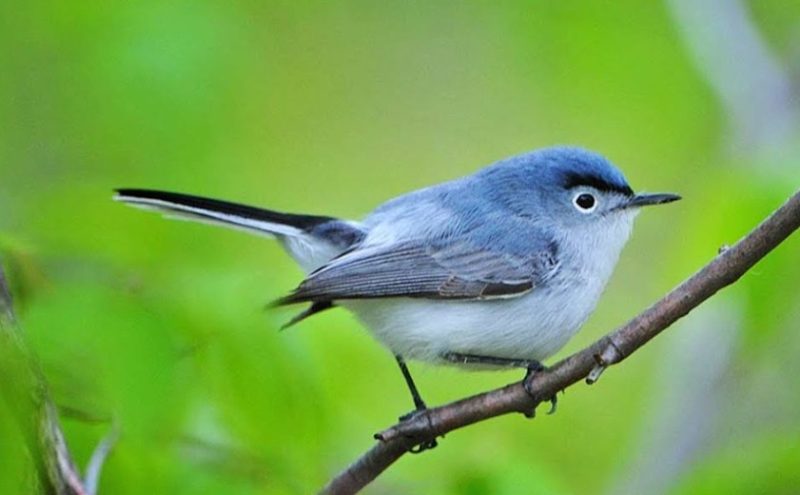
The Blue-gray Gnatcatcher is a tiny, agile songbird measuring around 4.3 to 5.1 inches (11 to 13 cm) long, easily recognized by its soft blue-gray plumage and distinctive long, slender tail with white outer feathers. It has a thin, pointed bill and a small black “cap” marking on males during the breeding season. These birds are highly active and quick-moving, often flicking their tails and hovering to catch small insects mid-air.
This species primarily feeds on tiny insects and spiders, gleaning them from leaves and twigs in deciduous forests and gardens. Their behavior includes rapid, acrobatic movements as they flit through branches searching for prey. Blue-gray Gnatcatchers build delicate, cup-shaped nests usually hidden in forks of tree branches, blending seamlessly into their surroundings.
In North Carolina, Blue-gray Gnatcatchers are common and resident year-round. They favor woodland edges, mixed forests, and suburban gardens with ample tree cover. Bird enthusiasts often spot them darting among branches, adding a lively presence to the state’s wooded landscapes throughout all seasons.
Barn Swallow

Barn Swallows are sleek, medium-sized songbirds measuring about 7.1 inches (18 cm) in length, easily identified by their glossy steel-blue upperparts, rusty-orange throat and forehead, and deeply forked tail. Their agile flight and swift aerial maneuvers make them impressive hunters of flying insects. Their chattering calls and twittering songs are familiar sounds during warmer months.
These birds feed almost exclusively on flying insects such as flies, beetles, and wasps, catching them on the wing with remarkable speed and precision. Barn Swallows often nest in man-made structures like barns, bridges, and eaves, constructing cup-shaped mud nests lined with grass and feathers. They are highly social and can be seen roosting in large groups.
In North Carolina, Barn Swallows are very common seasonal visitors, arriving in spring for breeding and leaving by late summer or early fall to migrate south. Their nesting sites are widespread throughout rural and suburban areas, making them one of the most recognizable and beloved blue birds of the region during the breeding season.
Tree Swallow
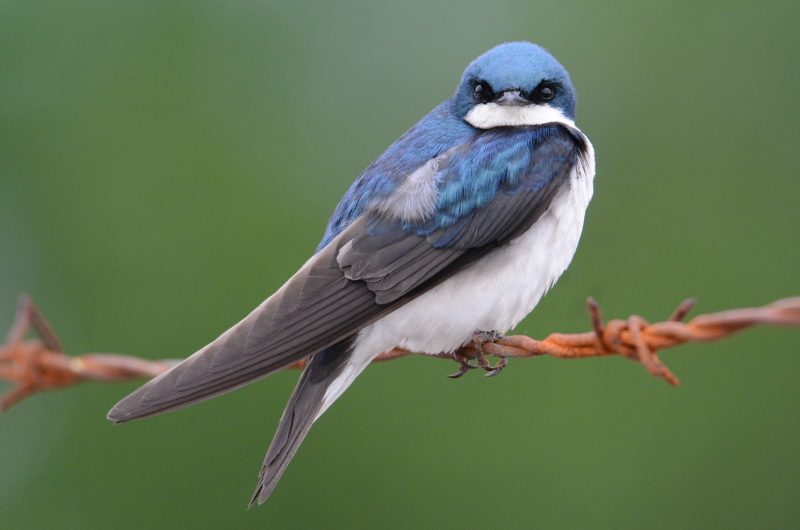
The Tree Swallow is a slender, graceful migratory bird measuring about 5.5 to 6.3 inches (14 to 16 cm) in length. It is easily identified by its iridescent blue-green upperparts contrasted with a clean white belly. Their streamlined bodies and long, pointed wings make them highly agile fliers, capable of impressive aerial maneuvers while catching insects mid-air. Their soft, twittering calls often accompany their swift flight patterns.
Tree Swallows feed almost exclusively on flying insects such as flies, beetles, and gnats, which they catch during sustained flight over fields, wetlands, and open water. They are cavity nesters, often using abandoned woodpecker holes or nest boxes placed near water sources. These birds exhibit social behavior during migration and often form large flocks in the fall.
In North Carolina, Tree Swallows are migratory visitors passing through during spring and fall. They do not typically breed in the state but can be seen stopping over in suitable habitats such as marshes and lakeshores during their journey between breeding grounds in the north and wintering areas further south.
Lazuli Bunting
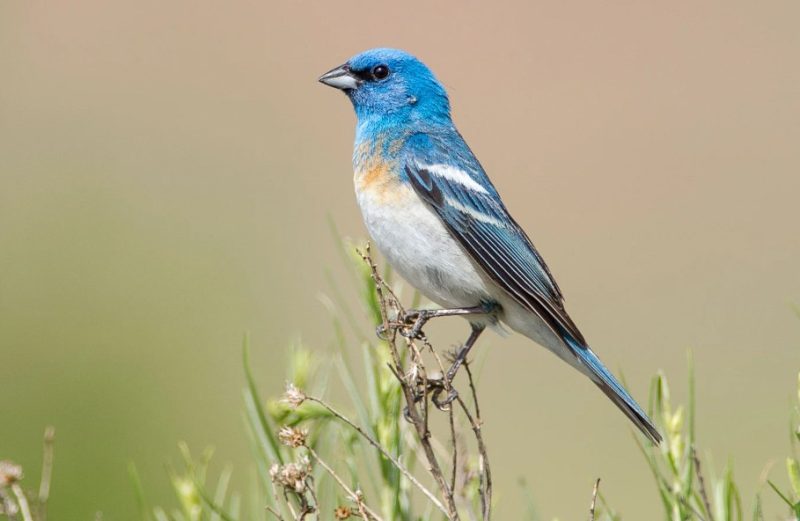
The Lazuli Bunting is a small songbird approximately 5 to 5.5 inches (13 to 14 cm) long, notable for its bright turquoise-blue upperparts and warm orange-brown flanks and breast. Males display vibrant coloration during breeding season, while females are duller with grayish-blue tones, providing effective camouflage. Their cheerful, buzzy song is a common sound in their western habitats.
This species primarily feeds on seeds and insects, often foraging in shrubs and low trees. Lazuli Buntings prefer open woodlands, brushy areas, and riparian zones, building cup-shaped nests well hidden in dense foliage. They are known for their shy behavior, often remaining concealed among thick vegetation.
Although mainly found in the western United States, Lazuli Buntings have been recorded as very rare vagrants in parts of the northeastern and southeastern U.S., including North Carolina. However, such sightings in North Carolina are extremely uncommon and sporadic, with no established populations.
Black-throated Blue Warbler
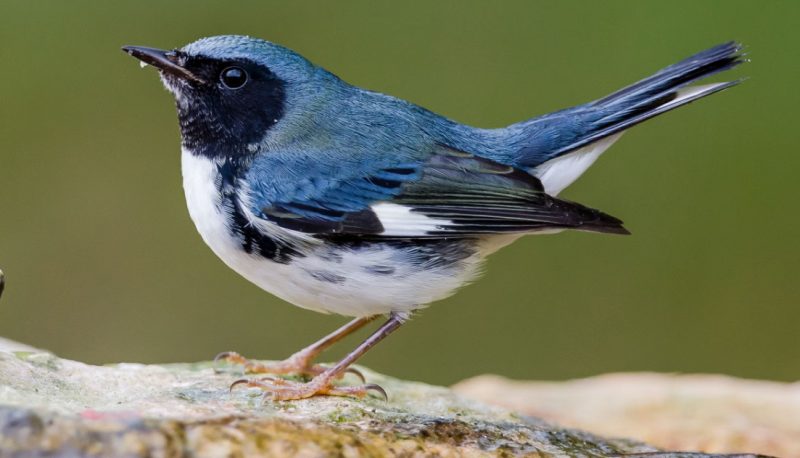
The Black-throated Blue Warbler is a small songbird, about 4.3 to 4.7 inches (11 to 12 cm) long, known for its striking sexual dimorphism. Males have deep blue upperparts, a jet-black face and throat, and a bright white belly, creating a sharp contrast. Females, in contrast, display olive-green upperparts with a yellowish wash on the chest and a faint white patch near the wing. Their clear, buzzy songs and sharp chips are typical sounds in their preferred habitats.
This species primarily feeds on insects and spiders, gleaning them from dense understory foliage. Black-throated Blue Warblers prefer mature deciduous or mixed forests with thick shrubs and a dense understory for nesting and foraging. Their nests are usually well-hidden low in shrubs or small trees, often in damp, cool forest environments.
In North Carolina, Black-throated Blue Warblers are common breeders and migrants, especially in the mountainous and piedmont regions. They favor the state’s rich forested areas during spring and summer, where their bold colors and active foraging behavior make them a favorite among birdwatchers exploring the dense woodlands.
Western Bluebird
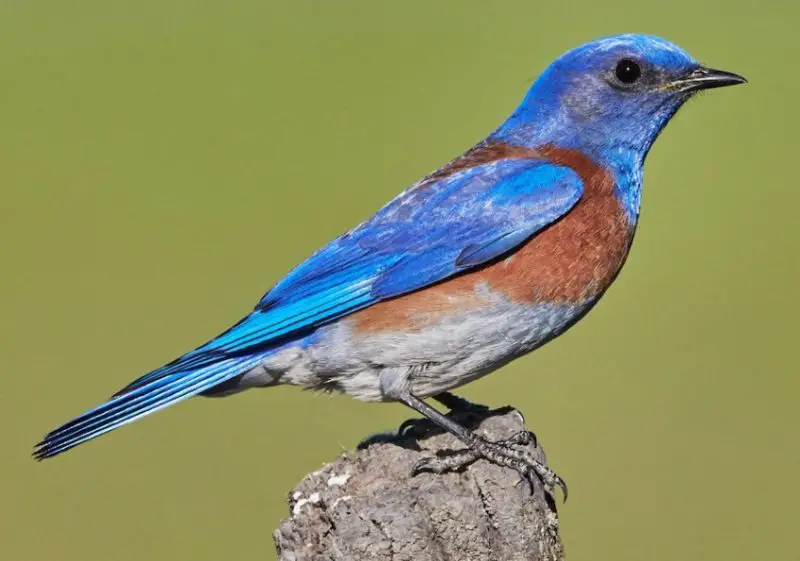
The Western Bluebird is a striking small thrush known for its vivid blue plumage contrasted with a warm rusty-orange chest. Measuring about 6.3 to 7.1 inches (16 to 18 cm) in length, it is slightly smaller than some other bluebirds but maintains a robust, compact body with a short tail. Males exhibit more vibrant blue coloring, while females tend to have duller, grayish-blue tones. Their soft, melodic songs and calls are often heard in open woodlands.
In terms of behavior, Western Bluebirds are generally insectivorous, feeding on beetles, caterpillars, and other small invertebrates, though they also consume berries during colder months. They prefer open habitats like meadows, edges of forests, and clearings, often nesting in tree cavities or nest boxes. Though primarily a species of the western United States, a few Western Bluebirds have been observed as rare vagrants in eastern states, including North Carolina, where sightings are considered unusual and infrequent.
In North Carolina, Western Bluebirds are rare and not commonly found. When present, they are most likely to appear during migration or as stray individuals wandering outside their typical range. Due to their limited occurrence, birdwatchers in the state consider any Western Bluebird sighting a special treat, but the species does not have established breeding populations in the region.
Northern Parula

The Northern Parula is a small, colorful warbler measuring about 4 to 4.5 inches (10 to 11.5 cm) in length, easily recognized by its vibrant blue-gray upperparts and bright yellow throat and chest. It has distinctive white wing bars and a subtle greenish patch on its back, often called a “parula patch.” Males typically display more vivid colors during the breeding season, while females are slightly duller. Its high-pitched, buzzy song is commonly heard in forested habitats.
This warbler primarily feeds on small insects and spiders, foraging actively among tree branches and leaves, often gleaning prey from moss and lichen-covered limbs. Northern Parulas prefer mature deciduous and mixed forests, especially near water sources like swamps or bottomland woods. They build compact cup-shaped nests suspended from tree branches, frequently hidden within moss or Spanish moss.
In North Carolina, the Northern Parula is a common breeding bird and migrant, found widely throughout suitable forested habitats across the state. It is especially abundant in moist woodlands during spring and summer, contributing vibrant color and lively song to North Carolina’s rich bird diversity.
Cerulean Warbler
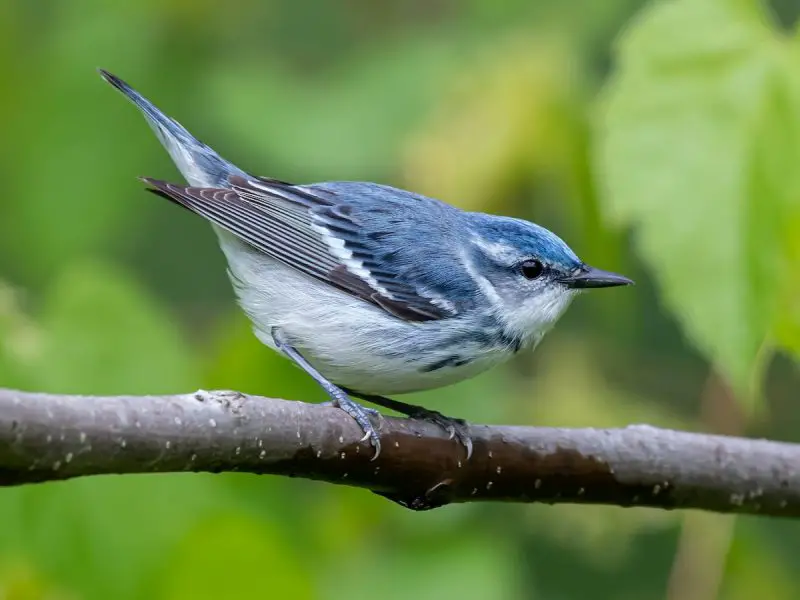
The Cerulean Warbler is a small songbird, approximately 4.3 to 5 inches (11 to 13 cm) in length, renowned for its stunning sky-blue coloration in males, contrasted with white underparts and subtle black streaks on the back. Females are duller, showing greenish-blue tones on the upperparts and paler underparts. This species has a delicate, buzzy song that can be heard in the forest canopy during the breeding season.
Cerulean Warblers primarily feed on insects and spiders, foraging actively in the upper canopy of mature deciduous forests. They prefer large tracts of uninterrupted hardwood forest with tall trees for nesting and feeding. Their nests are typically built high in the canopy, often on horizontal branches, making them difficult to observe.
In North Carolina, Cerulean Warblers are considered uncommon but present during the breeding season, mainly in the mountainous regions where mature forests remain. Due to habitat loss and fragmentation, their populations have declined, making them a species of conservation concern. Birdwatchers in North Carolina treasure any sightings of this beautiful and elusive warbler.
FAQ About Blue Birds in North Carolina
What are some common blue birds found in North Carolina?
North Carolina hosts a variety of blue birds, including the Eastern Bluebird, Blue Jay, Tree Swallow, Indigo Bunting, and Belted Kingfisher. These species can be spotted in different habitats such as forests, fields, wetlands, and suburban areas.
When is the best time to see blue birds in North Carolina?
The best time to observe blue birds in North Carolina is during the spring and summer breeding seasons when many species are most active and visible. Migration periods in spring and fall also offer chances to see migratory blue birds like the Tree Swallow.
Do blue birds in North Carolina stay year-round or migrate?
Some blue birds, like the Blue Jay and Eastern Bluebird, are year-round residents in North Carolina. Others, such as the Tree Swallow and Barn Swallow, are migratory and only present during spring and summer months.
What habitats do blue birds prefer in North Carolina?
Blue birds in North Carolina inhabit diverse environments. Eastern Bluebirds prefer open fields and meadows, Blue Jays thrive in forests and suburban areas, and Belted Kingfishers are commonly found near rivers and lakes.
How can I attract blue birds to my backyard in North Carolina?
To attract blue birds, provide natural food sources such as insects and berries, install nest boxes for cavity-nesting species like Eastern Bluebirds, and maintain native shrubs and trees for shelter and foraging.
Are any blue bird species in North Carolina endangered or threatened?
Most blue bird species in North Carolina have stable populations, but habitat loss can impact some, such as the Cerulean Warbler, which is considered a species of conservation concern due to declining mature forest habitats.



